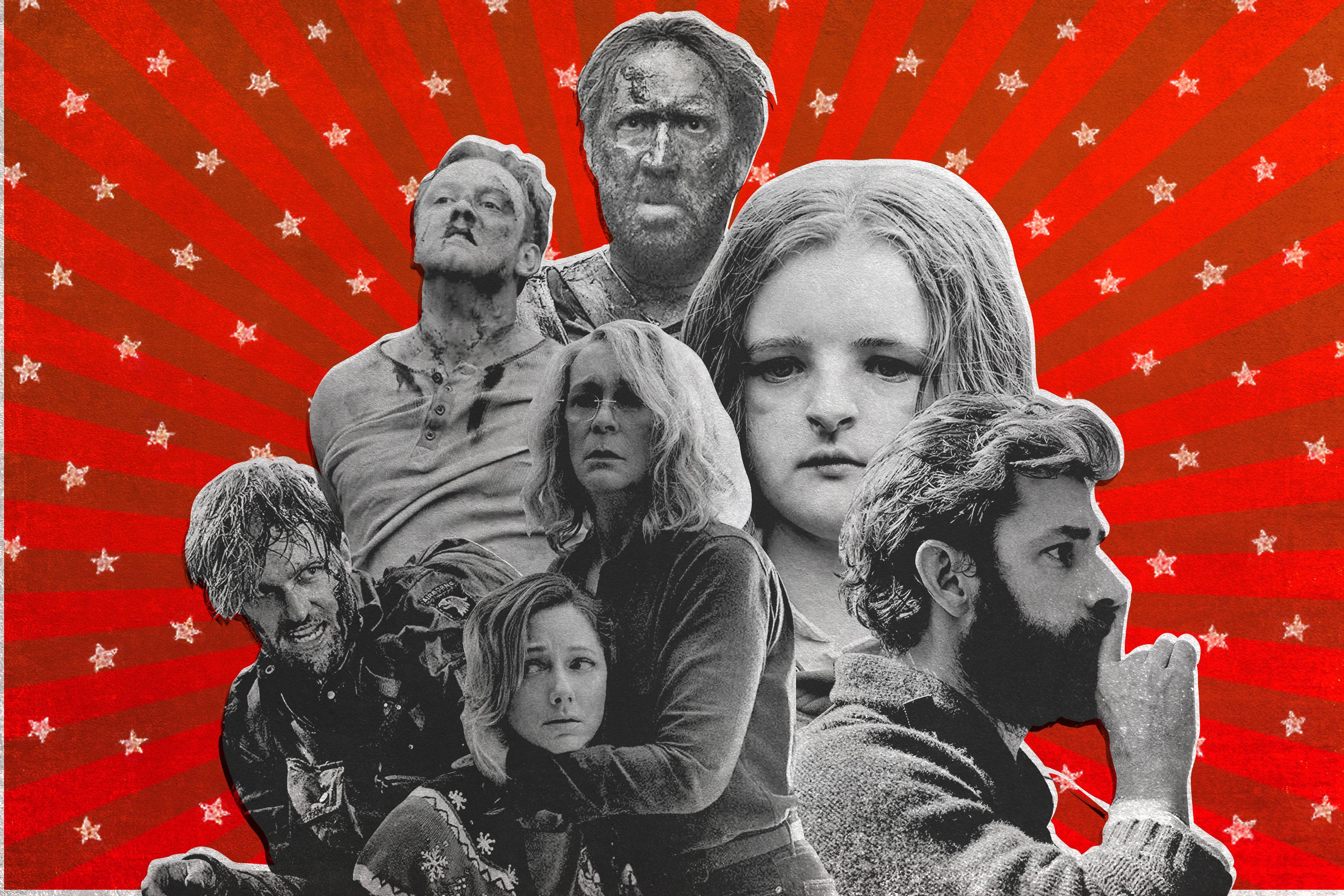The 10 Best Horror Movies of 2018
From family trauma to Nazi zombies, this year’s scary movies ran the gamut from gross to grandioseHorror has never been bigger than it is right now. Its receipts grow at the box office, its long-overdue recognition as a genre of import continues apace, and the shape of a quality horror movie is regularly redefined. While 2018 may not have had an era-defining classic like Get Out, it was riddled with discomfiting and disquieting entries. Here are Sean Fennessey and Chris Ryan’s 10 best.
10. Cam
Directed by Daniel Goldhaber (Blumhouse/Netflix)
During a year when the internet became the newest tool with which Hollywood obsessively told stories — in movies as varied as Ralph Breaks the Internet, Searching, and Assassination Nation — it was horror where the ominous dread of a blinking cursor truly took hold. This first-time feature from Goldhaber and writer Isa Mazzei (a real-life former “camgirl” performer) accomplishes two of horror’s key goals — it drops the viewer into a new and unnerving world (the unlikely marketplace of cam channels), and uses the discomfort in the space to twist our minds into submission. No movie this year was more merciless about sex, voyeurism, image, and the cost of watching too closely. Call it a selfie slasher. — Sean Fennessey
9. The Open House
Directed by Matt Angel and Suzanne Coote (Netflix)
What if The Strangers were an Airbnb review? That’s basically the pitch for this under-the-radar Netflix thriller from January. Struggling to make ends meet, a widow and her teenage son (played by 13 Reasons Why’s Dylan Minnette) move into a secluded house in the mountains. It’s more than they can afford, but there’s a catch: They have to be out whenever the home is being shown to prospective buyers. This, of course, leads to some unwelcome guests. The final third of The Open House borders on torture porn — so your mileage may vary — but it’s made all the more terrifying because of the empathy you feel for the two main characters. Their grief, loneliness, and economic hardship gets as much play as the thing that goes bump in the night. — Chris Ryan
8. Summer of 84
Directed by François Simard, Anouk Whissell, and Yoann-Karl Whissell (Gunpowder & Sky)
Most Amblin-aping entertainment — Super 8, Stranger Things — pits the suburbs against the great unknown (hidden dimensions, extraterrestrial life). The teens in Summer of 84 don’t have to look that far for thrills; they find them right next door. Set in a sleepy Oregon town, this effort from the filmmaking trio RKSS is about a group of kids who spend summer break on the trail of the Cape May Slayer. BMX bikes and synth scores are pretty stale at this point, but there’s something endearing (and terrifying) about watching the wild imaginations of the protagonists prove not that wild after all. — CR
7. The Ritual
Directed by David Bruckner (Netflix)
The steady popularity of horror movies means that you routinely find very fine actors in the scariest of places. Bruckner’s debut solo feature is the story of a group of old friends hiking through rural Sweden who make a very wrong turn in a very dark forest. Needless to say, things get very Blair Witch. The real selling point is Rafe Spall’s lead performance as Luke, the most shallow and cowardly of the bunch, who is forced to become something like a leader as his friends go down, one after another. Any movie that features cults and woodland beasts doesn’t need a great actor doing great acting — but it sure doesn’t hurt. — CR
6. Halloween
Directed by David Gordon Green (Blumhouse)
Pay homage. That’s all Green had to do with the 11th installment in John Carpenter’s historic franchise. He did that and then some. I’m fond of Green’s vision of the anxiety around Michael Myers, and the way survivors reload their shotguns even if they can’t reset their lives. This may be Jamie Lee Curtis’s greatest performance, as a frantic, paranoid, ferocious, white-knuckling Laurie Strode. She is the heartbeat of the franchise, and versions without her have been missing something ineffable. Without JLC, there is no Halloween (1978). And without JLC, there is no Halloween (2018). — SF
5. Unfriended: Dark Web
Directed by Stephen Susco (Blumhouse)
Making techno horror is a bit of fool’s errand. By the time the movie comes out, another realm of debased online behavior has been discovered. Somehow, at the end of 2018, Unfriended: Dark Web — with its tales of evil Silk Road–esque bazaars where buyers pay to watch people suffer — seems almost quaint. What’s really scary is the way Susco tells his story. He taps our probably-definitely-terrible-for-us newfound ability to juggle lots of different pieces of information all at once — from chat windows, to social media feeds, to video — and makes the audience complicit in the crimes. — CR
4. Overlord
Directed by Julius Avery (Paramount)
Wake up on a Tuesday, this is a Nazi-killin’ WWII adventure movie. On a Wednesday, it’s a chamber drama whodunnit. On a Thursday, it’s a buddy comedy. But on Fridays, it’s pure zombie body horror. Avery’s categorical brain scrambler features some of the gnarliest and most fun practical makeup and effects work seen in years, and the gurgling, slithering little pustule of a movie is a blast. You’ll wince and smile at the same time. — SF
3. Mandy
Directed by Panos Cosmatos (RLJE)
This majestic, mad-eyed revenge tale also made its way onto our Best Action Movies list. It’s a shapeshifter, from Heavy Metal–inspired fantasia to demonic possession shocker to downhome hillbilly horror. Cosmatos has influences coming out his ears. But more than anything, it’s a living nightmare. Nicolas Cage’s berserker, go-for-broke energy is perfectly employed as a man whose wife has been kidnapped and subject to the whims of a foppish cult leader. Andrea Riseborough’s equally committed performance as the titular character — virulent in the face of evil — is inspired. And Cosmatos’s cosmic haze — like 2001’s Star Child sequence, but shot in reverse — is among the most arrestingly ugly compositions of the year. — SF
2. A Quiet Place
Directed by John Krasinski (Paramount)
When Krasinski took on A Quiet Place, he was a self-confessed horror movie newb, and the final product has a kind of simplicity that doesn’t feel weighed down by overfamiliarity with genre conventions. It asks very simple questions: What if there were something terrible out there, and the only way to stay safe was to stay quiet? And what if, in the face of this terror, you still tried to raise a family? The meta-casting of Krasinski and his real-life spouse, Emily Blunt, as the couple at the heart of the story gives the movie a layer of psychological complexity that the screenplay might not have had on the page. And for as much as Kraskinski auteured the hell out of this thing, it’s Blunt’s movie: her expressive, anguished acting is Silent Film Star stuff. — CR
1. Hereditary
Directed by Ari Aster (A24)
I believe Aster when he says this is more family trauma than pro forma genre. He’s certainly working out some complex ideas about how parents infect their children with their most insidious ideas. Horror isn’t always a grand Trojan horse used to mask deeper political, social, and emotional ideas. Sometimes it’s just a factotum, a framework. Most of this movie feels like Ordinary People meets The Innocents. The final quarter of Hereditary, which begins to more closely resemble classic horror tropes, has been criticized by some hardliners. But it’s that pivot that makes it finally work. The conspicuousness of the terror to that point, the awful, relentless agony that Aster puts his audience — and the Graham family — through ultimately arrives at a hysterical and absurdist conclusion. It’s the little triggers — the tongue-clicking, the miniatures, that awful car accident, the desk-smashing, the man set ablaze — that are used to build the traumatic tension. The ending isn’t the payoff, it’s just the rationale. — SF


